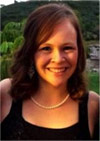Exploring the History of the Holocaust in Budapest

As I continued to walk along the Danube, I saw something I recognized, but had only ever seen in photos and heard about in testimony. The dozens of bronze shoes near the edge of the river, a memorial to the thousands of Jews that were marched to the riverbank, shot by the Arrow Cross, their bodies left to flow down the river. The romance disappeared and tears started to fill my eyes. I stand there almost numbed by the history, while a young person sits near the shoes smiling for photos and laughing as if nothing horrific had ever happened there.

I traveled to Budapest, Hungary, to cover the 2016 Master Teacher (formerly Teaching with Testimony) Workshop, an annual summer program offered to teachers through an application process for a one-week training on how to teach with Holocaust survivor testimony from the Visual History Archive.
My role was to cover this program for our communication department. I was a fly on the wall but like so many times, I felt part of the program by listening to testimony. The first day of the program, educators go on an IWalk of the Jewish district – to learn in-depth about Jewish life in Budapest before, and during the Holocaust. The goal is that teachers will adapt this program into their curriculum.
We first arrived at the Dohány Street Synagogue, the largest in Europe and second largest in the world. It is a breathtaking view, columns that extend into the sky with tourists buzzing about. During the IWalk, we learned that in 1944 Jews were forced into the Budapest ghetto, which was the Jewish quarter including the synagogue. We watched testimony in the places that are referenced in the clips of testimony. In the courtyard of the synagogue, I again recognized a memorial, this time the tree of memories – 30,000 names of those who were killed in the Holocaust in the Raoul Wallenberg Memorial Park. I had seen and used photos of this memorial dozens of times for my work, but it wasn’t until I visited it in person I learned each metal leaf has a name. I felt a pit in my stomach and the tears started to well up.

We continued our walk through the Jewish quarter, which ironically is the hip young party scene of Budapest. Walking at night, it feels almost like the Silver Lake neighborhood of, Los Angeles – bars, restaurants, young professionals like myself enjoying drinks after a day of work. But I wonder, do they know?
In a few hours of spare time during my week in Budapest, I enjoyed a bus tour and as I learned about the history of the city I wondered how the tour would talk about the Holocaust. We drove by the synagogue and again I marveled in its beauty and existence. And the tour mentioned its importance and size, and the tree memorial, but not the names of the dozens of individuals and diplomats who risked their lives to save Jews. It briefly mentioned the 30,000 memorialized on the tree, but didn’t mention how families were ripped apart, how thousands were shot and then had their bodies left to flow down the river, children seeing their mothers dragged away. Not one mention. How different could our world be if each individual on this tour listened to a clip of testimony just for a few minutes to get an understanding of what happened before the hip bars were established?
I know that listening to Holocaust survivor testimony is probably the last thing people want to hear on their vacation. But this happened here in this place – thousands of people were discriminated against, dehumanized and then murdered in Budapest only 70 years ago. We need to be aware. I understand we can’t dwell in the past but we should be able to learn from it.
We can’t dwell in the past but we should be able to learn from it.
This is why educator workshops in Hungary and throughout the world are essential. We are training educators to teach a difficult history through eyewitness testimony.
When you visit a place across Europe, United States and anywhere else in the world, stop and think about the history, how it is remembered in the present and what you can do to help the future.
Visit the Visual History Archive Online to explore eyewitness testimony to the Holocaust and other genocides.
